Our portfolio of care homes provides essential health and social infrastructure from where care is provided for some of the UK’s most vulnerable people. We partner with our tenants to improve the built environment, operational efficiency, and the environmental and social impact. Quality homes and strong long-term partnerships with our tenants help us to achieve positive outcomes for society, while generating sustainable cash flows for our shareholders.
Having identified and assessed the material issues, we have distilled the overarching themes and used them to define the three pillars of our ESG strategy. Improving the UK’s social healthcare infrastructure is at the heart of our investment strategy and is therefore a central pillar of our ESG strategy. We will combine this with a robust focus on the environmental impact of our portfolio and making sure we have a comprehensive governance framework. Our approach to responsible business is based on the following three pillars.
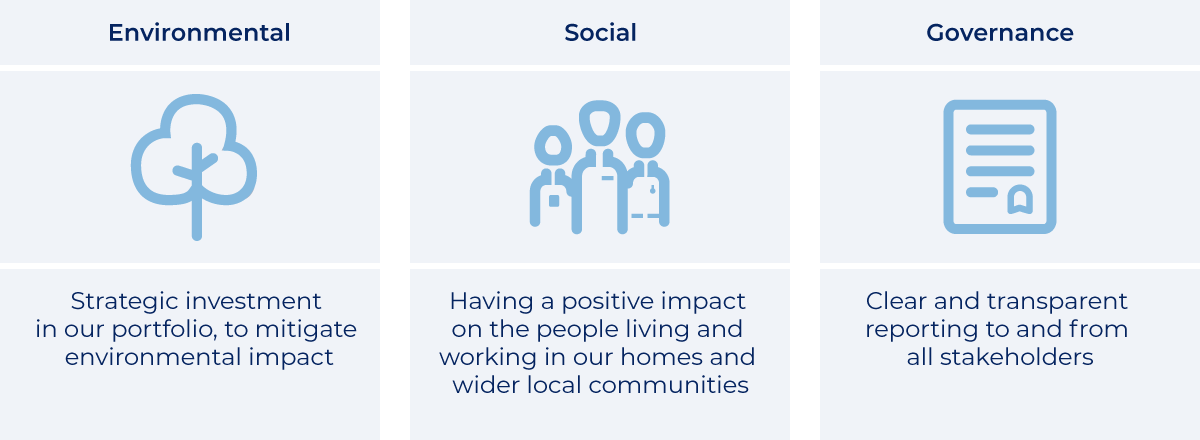
1. We invest in an environmentally responsible manner. We fully consider the environmental impact of the assets we invest in, including:
2. We invest in vital social care infrastructure that enables high quality care to be provided to some of the most vulnerable people in society from both the state-funded and self-pay sector. We have a differentiated approach with an investment strategy in mid-market homes that creates social impact in the following ways:
3. We manage the business in an open and transparent manner by:
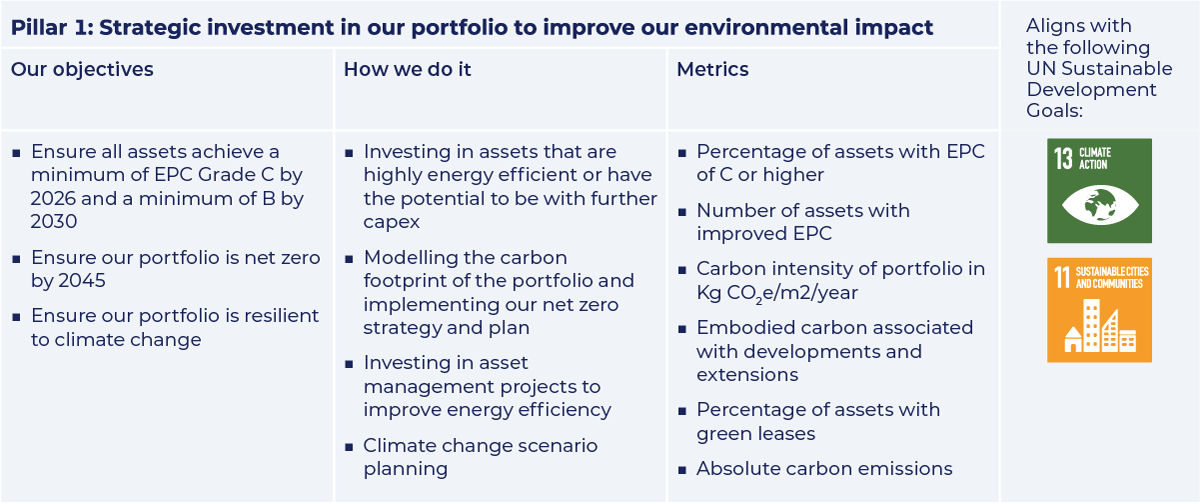
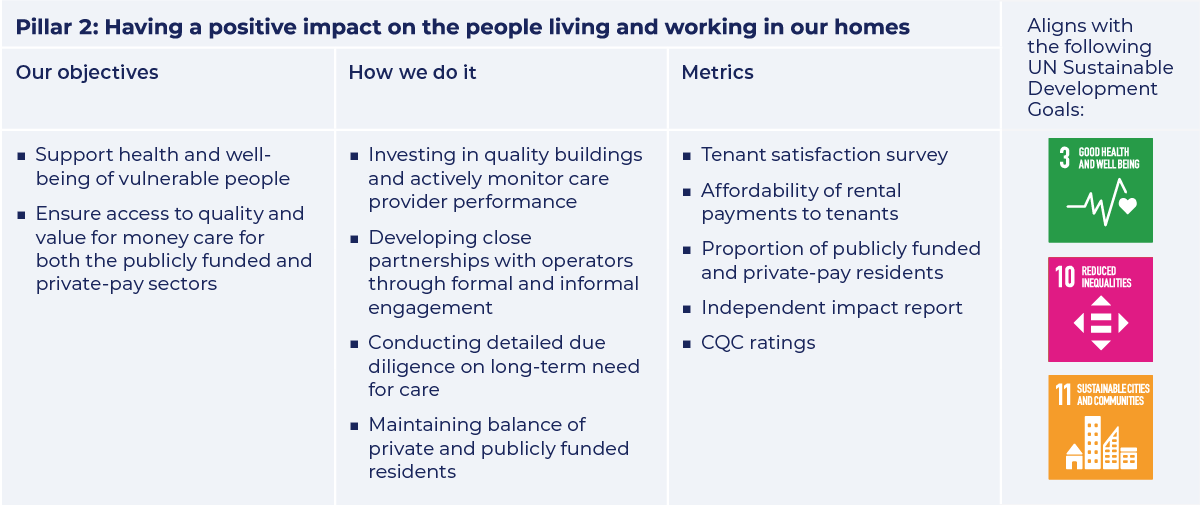
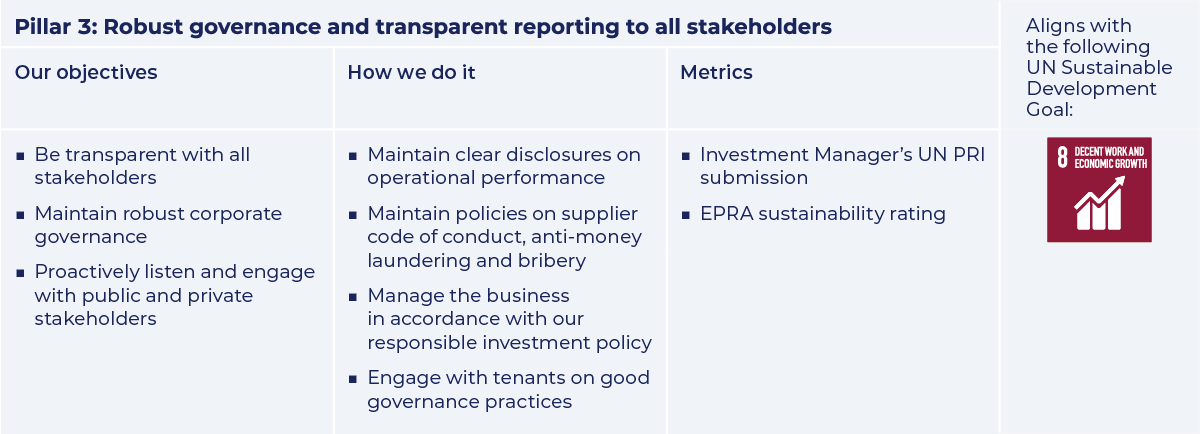
The majority of residents in our homes are funded by their local authority or the NHS. Homes for publicly funded residents have traditionally had less investment than those for private payers. This gives us an important role as a long-term capital partner for operators who deliver vital care to residents who may have less choice. These homes can also free up much needed bed space for the NHS, improving people’s lives by reducing the time they spend in hospital and providing them with appropriate community-based care. Our homes also benefit the wider community and sustain and create local employment. We believe therefore that our long-term investment in these homes delivers positive social outcomes for residents and their families and for the staff providing care in a community setting. We aim to have a portfolio that continues to serve both the publicly-funded and private-pay markets, with appropriate rents that allow our tenants to provide a sustainable and commercially viable care service for people, irrespective of their background. This balanced approach gives us a prudent and resilient commercial strategy, enables our tenants to grow their businesses and helps us deliver substantial positive social impact.
Our Annual Impact Assessment 2022 can be found in the Reports archive at the bottom of the page.
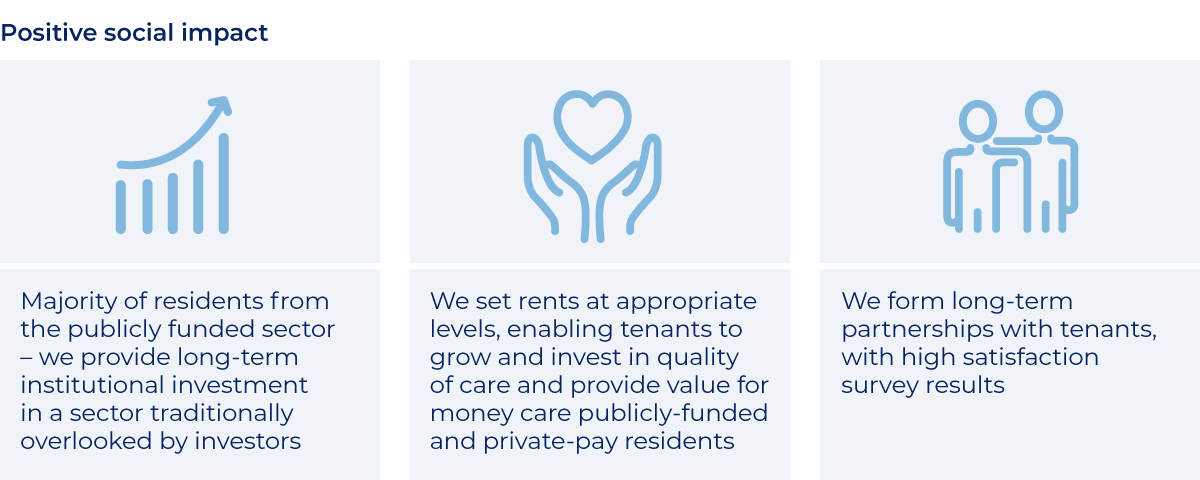
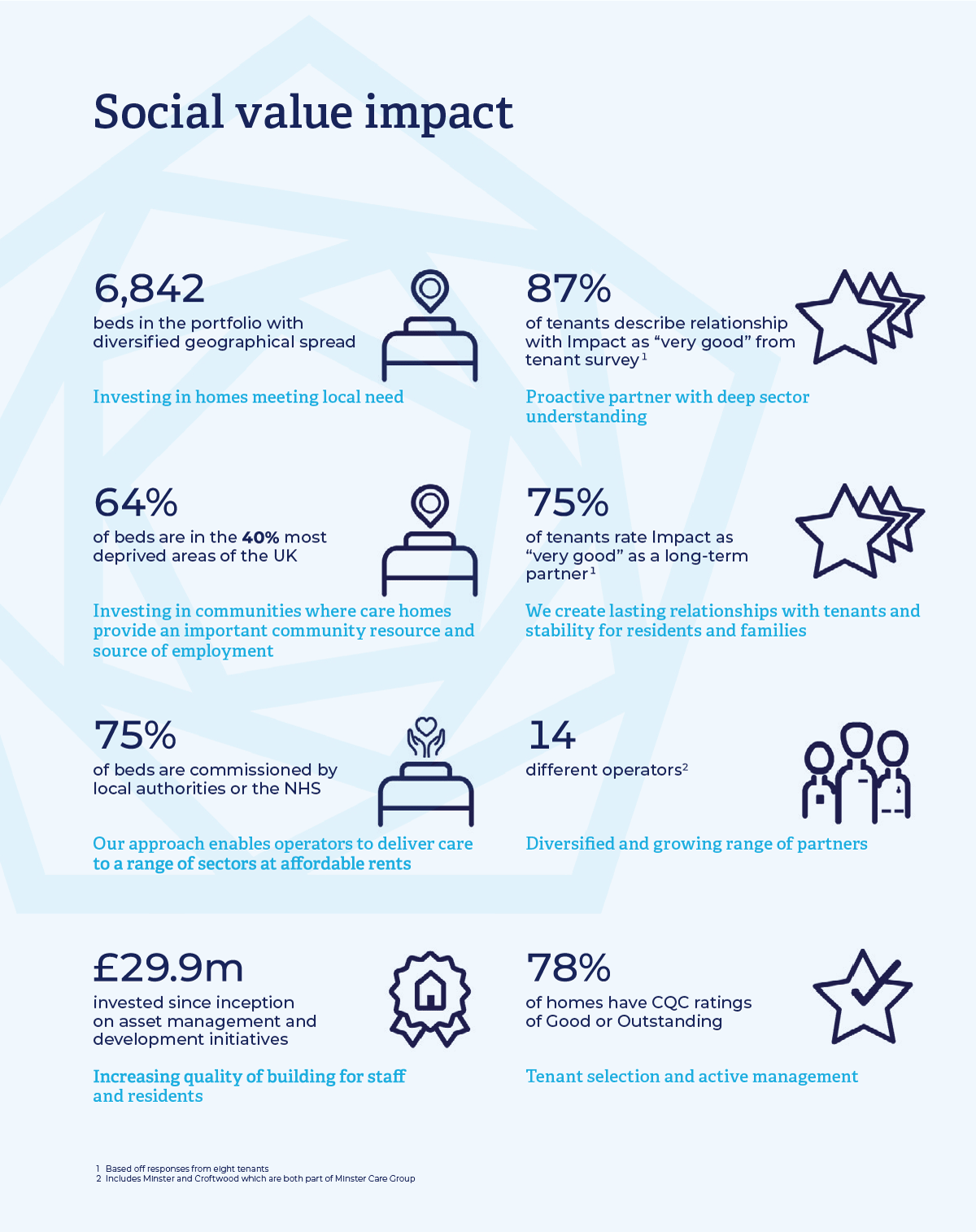
To help to futureproof our portfolio and preserve its value, we’ve developed a net zero strategy and delivery plan. To do this, we used the industry-leading CRREM (Carbon Risk Real Estate Monitor) toolkit. This shows the decarbonisation trajectory required for us to comply with the 2015 Paris Climate Agreement target to limit the global temperature increase to 1.5 °C. The CRREM toolkit is the major global standard for operational decarbonisation of buildings and its pathways are aligned with science-based targets. We’ve developed our net zero strategy with the assistance of a leading sustainability consultancy. We have applied the principles of the energy reduction hierarchy (see the diagram below) to the stages of the real estate lifecycle, to ensure our decarbonisation pathway is as efficient and cost effective as possible. Initially, we’re focusing on reducing energy demand by engaging with our tenants and through measures such as installing LED lighting and insulation upgrades. The next stage will be more substantive retrofits and moving from fossil fuel heating systems to low-carbon electrical systems, alongside a roll out of on-site renewable energy sources such as solar PV cells. We’ll offset any residual carbon emissions using recognised offsetting programmes, in accordance with the UK Green Building Council guidelines. Importantly, we have included all tenant energy and refrigerant carbon emissions in our decarbonisation strategy, which are classed as “Scope 3” under the Greenhouse Gas Protocol. We consider this to be a responsible and transparent approach to the environmental impact of our portfolio.
We have set interim targets for our net zero strategy and delivery plan, which we will continue to monitor and review as we progress.
| Year | Reduction in absolute carbon emissions on a like-for-like basis | Percentage of assets with an EPC of B or above† |
|---|---|---|
| 2025 | 15% | 50% |
| 2030 | 50% | 100% |
| 2045 | 90%* | 100% |
* At present we estimate that there will be some residual carbon emissions which we will offset. This will be kept under review as low carbon options become more widely available and effective.
† There may be cases where exemptions apply under MEES regulations in which case we will provide all viable energy efficiency measures. EPC B is for England & Wales only but an equivalent rating will be sought for assets in Scotland.
The chart below shows the effect of different actions on the carbon intensity of our portfolio. Our approach is to deliver a methodical, planned and considered decarbonisation plan working in partnership with our tenants. Based on current assumptions on available technology we estimate that we will be fully net zero in 2045, well ahead of legislative targets. We will continually review this pathway to assess whether we can accelerate this process as new low carbon options become more widely available and effective. The pathway has also been developed on the basis that the government preferred approach to the Minimum Energy Efficiency Standards (MEES), which will require all buildings to be an EPC B rating or above by 2030, comes into effect.
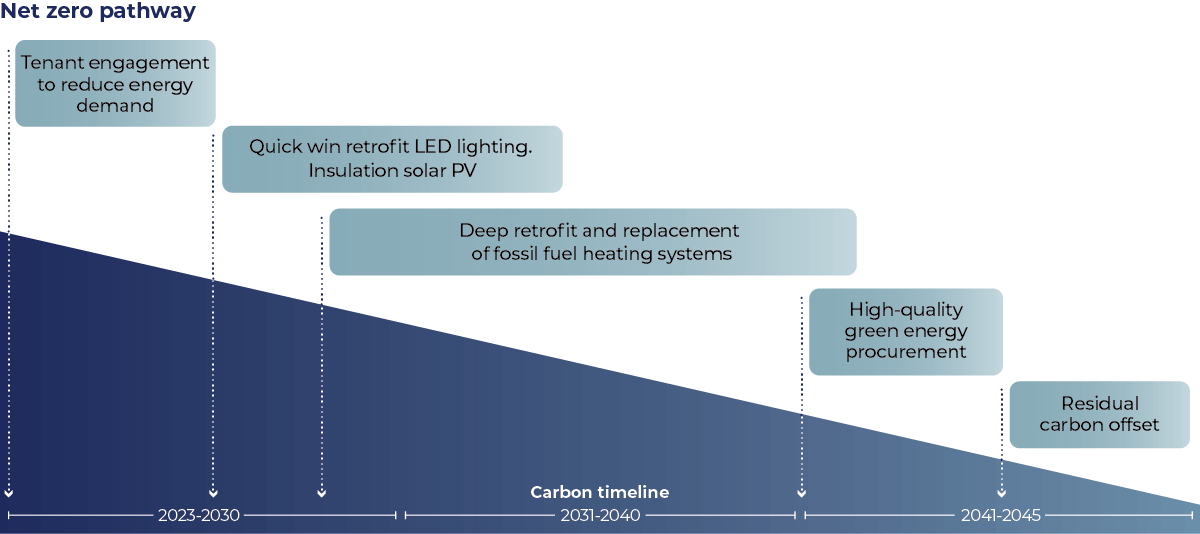
Through the 2015 Paris Climate Agreement, world governments have committed to keeping the global temperature rise to well below 2°C above pre-industrial levels and are working to limit warming to 1.5°C. In the UK, the government aims to reduce emissions by 78% by 2035 and achieve net zero by 2050. It has made net zero by 2050 part of UK law, providing opportunities to introduce further legislation and regulations to promote change.
Climate change and the laws and regulations needed to mitigate it create both risks and opportunities for our business. During 2022, the board oversaw the Investment Manager’s work in this area. This included developing an initial analysis of our portfolio, defining the actions we need to take to decarbonise the portfolio over time and increasing our focus on physical risks during acquisitions and portfolio management.
Being accountable for and transparent about how we assess and manage climate-related risks and opportunities is important for maintaining our stakeholder relationships. We’re therefore reporting against the Taskforce on Climate-Related Financial Disclosures (TCFD) recommendations for the first time this year. As an investment company, we’re not currently required to report against TCFD, but we believe starting to do so helps our stakeholders to understand the possible effect of climate change on our business and the actions we are taking.
This is our first year of voluntary reporting against the TCFD framework and we are making progress towards full compliance with the TCFD requirements. We expect to improve our compliance in future years as we continue to refine our assessment of climate change risks and opportunities and embed climate change risk management in our day-to-day operations and acquisitions. The implementation of our net zero strategy, targets and delivery plan will also be kept under close review.
A copy of the TCFD report is available to download from the Reports archive below.
IHR-EPRA-Sustainability-Best-Practice-Performance-Report-2023.pdf
IHR-EPRA-Sustainability-Best-Practice-Performance-Report-2022.pdf
IHR_Annual-Impact-Assessment-2022.pdf
Impact-Healthcare-REIT-plc-TCFD-2022.pdf
EPRA-Sustainability-Reporting-2021.pdf
EPRA-Sustainability-Reporting-2020-1.pdf
EPRA_BPR_Awards_2020_-_Survey_Report_HD_1599221888159.pdf
EPRA-Sustainability-Reporting-2019-1.pdf